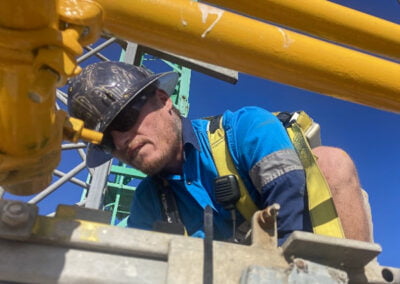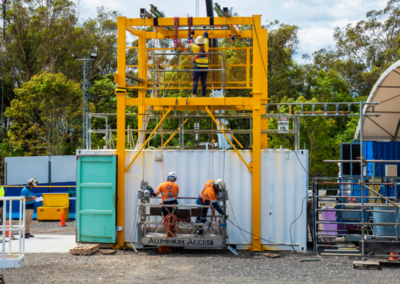FAQ: Working Safely at Heights in Queensland
Employment & Careers | 5 Minute Read
Written by Jimmi Nolan
Join our mailing list for 10% off your next course Subscribe

Working Safely at Heights: Some facts about Height Safety
We took this photo in the yard recently and felt it had a ‘Lunch atop a Skyscraper‘ vibe to it, the famous photo taken in 1932 of workers enjoying lunch upon an iron girder 260 metres above ground during construction of the RCA building in New York City.
Height safety and construction safety standards in general have moved on from then of course around the developed world.
Any rigger erecting and dismantling tower cranes though can attest to the very real danger that still exists in this line of work, despite these standards and even the fall arrest systems designed to protect them.
Of course our riggers here are only a few metres up and in the controlled environment of our yard, but the action shot does depict the pseudo construction site environment we’ve tried to create, with plenty of plant and construction activity working together in close proximity.
But sometimes that’s exactly where the danger can lie, in complacency about taking risks working at minimal height with so many fall-from-height incidents occurring from ladders.
And on a construction site, one must always be aware and, continually assess hazards, as and when they arise, implement control measures to manage them as outlined in all the courses we offer and recorded in SWMS.
So perhaps as you read this you might be thinking about your own safety on site, or of those of your workers.
Are you/they compliant but ultimately safe as possible to themselves and others?
Have you/they had sufficient training at height?
Have the highest possible measures from the five levels in the hierarchy of controls relating to work at height been implemented on site?
According to Worksafe Australia, in 2022 9% of workplace fatalities were due to falls-from-height.
Worksafe Victoria reported over a third of the 1352 falls-from-height claims in 2023 were from the construction sector.
Most of these were from falling off ladders, but also stairs and stairways, buildings and structures, scaffolding, openings in floors, walls and ceilings.
So how do you ensure you and/or you workers are safe at height?
If you’re seeking further training or advice about height safety, check out some of the links below for more information.
We recommend:
- Working from Heights in the Spotlight – ‘Safety Solutions’ Article
- ‘Work at Heights‘ page on the Worksafe Queensland website
- Working Safely at Heights (RIIWHS204E) courses
- Independent workplace/site safety audits
Or, keep scrolling for FAQ’s about working at heights in Queensland 👇
📸 Charles C. Ebbets (unconfirmed), 1932
FAQs About Working Safely at Heights
1. What are the regulations for working safely at heights in Queensland?
The regulations for working safely at heights in Queensland are outlined in the Work Health and Safety Regulation 2011. These regulations require that all workers who perform tasks at height must be trained and competent in height safety procedures. Employers must ensure that appropriate safety measures, including the use of personal protective equipment (PPE) and fall arrest systems, are in place to prevent falls and injuries.
2. How often should you refresh your working at heights qualification?
It is recommended to refresh your working at heights qualification every two years. This ensures that workers stay up-to-date with the latest safety standards, regulations, and best practices. Regular refresher courses also help reinforce safety knowledge and skills.
3. When is a working at heights qualification required in the construction industry?
A working at heights qualification is required in the construction industry whenever a worker is required to perform tasks at a height where there is a risk of a fall that could cause injury. This includes tasks such as working on ladders, scaffolding, roofs, or any elevated work platforms. The qualification ensures that workers are aware of the hazards and trained in the proper use of safety equipment and procedures.
It does depend on the type of work being undertaken and where, and at what height, and there are specific controls required related to construction work. There’s too much granular information to be listed in this FAQ blog, so visit the ‘Work at Heights‘ page on the Worksafe Queensland website for more detailed information including links to regulations, safety acts and codes of practices.
4. What are the five levels in the hierarchy of controls for working at height?
The five levels in the hierarchy of controls for working at height are:
- Elimination: Remove the need to work at height if possible.
- Substitution: Use equipment or methods that reduce the need to work at height.
- Engineering Controls: Implement physical measures, such as guardrails, to prevent falls.
- Administrative Controls: Implement procedures and training to minimize risks.
- Personal Protective Equipment (PPE): Use fall arrest systems and other protective gear.
5. What should be included in a Safe Work Method Statement (SWMS) for working at heights?
A Safe Work Method Statement (SWMS) for working at heights should include:
- A description of the work to be carried out.
- The hazards associated with the work.
- The control measures to be implemented to manage the risks.
- The responsibilities of workers involved in the task.
- Emergency procedures in case of an incident.
6. What are examples of working at heights tickets?
The most common example of a working at heights ticket in Queensland is the nationally recognised RIIWHS204E – Work Safely at Heights certification. This course is designed to provide participants with the skills and knowledge required to work safely at heights in various industries, including construction, maintenance, and more.
Course Duration:
- The RIIWHS204E qualification typically takes one day to complete, including both theoretical and practical training components.
Key Points Covered in RIIWHS204E:
- Legislation and Regulations: Understanding the legal requirements and standards for working at heights, including the Work Health and Safety Regulation 2011.
- Risk Assessment and Hazard Control: Learning how to conduct risk assessments and implement control measures to manage the risks associated with working at heights.
- Fall Prevention Systems: Training in the use of fall prevention equipment such as guardrails, safety nets, and work positioning systems.
- Fall Arrest Systems: Instruction on the proper use of fall arrest systems, including harnesses, lanyards, and anchorage points.
- Emergency Procedures: Developing skills to respond effectively to emergency situations, including rescue techniques and first aid for fall-related injuries.
7. What are the common causes of falls from height in the construction sector?
Common causes of falls from height in the construction sector include:
- Inadequate safety measures or failure to use fall protection equipment.
- Slips, trips, and loss of balance on ladders, scaffolding, or uneven surfaces.
- Unsafe use of equipment such as ladders or scaffolding.
- Lack of proper training and supervision.
8. What are the penalties for non-compliance with height safety regulations in Queensland?
Penalties for non-compliance with height safety regulations in Queensland can include fines, prosecution, and imprisonment for serious breaches. Employers and individuals found to be in violation of the regulations may face significant financial penalties and legal consequences.
9. What’s the best way to find out if a site is compliant with regards to working at heights?
The best way to determine if a construction site is compliant with working at heights regulations is to conduct a thorough site safety audit. This process involves reviewing all aspects of height safety on-site to ensure that all legal requirements and best practices are being met.
Steps to Ensure Compliance:
Internal Safety Audit:
- Conduct regular internal safety audits using a checklist based on current regulations and standards.
- Ensure all workers have up-to-date qualifications, such as the RIIWHS204E – Work Safely at Heights certification.
- Review and update Safe Work Method Statements (SWMS) to include detailed procedures for working at heights.
Independent Site Safety Audit:
- Engage an independent advisor to perform a site safety audit. This external perspective can help identify potential compliance gaps that internal audits might miss.
- An independent site safety audit typically includes:
- Review of Documentation: Checking training records, SWMS, risk assessments, and incident reports.
- Site Inspection: Examining all areas where work at heights is performed to ensure proper safety measures are in place.
- Equipment Check: Verifying that all fall prevention and fall arrest systems are correctly installed, maintained, and used.
- Worker Interviews: Speaking with workers to assess their understanding of height safety procedures and their adherence to them.
- Compliance Report: Providing a detailed report outlining any deficiencies and recommendations for improvement.
Regular Training and Refreshers:
- Ensure all workers undergo regular training and refresher courses (recommended every 2 years), such as the RIIWHS204E, to stay current with the latest safety practices and regulations.
Implementation of Control Measures:
- Apply the hierarchy of controls for working at heights, prioritising elimination and substitution methods to reduce the need for working at height whenever possible.
- Implement engineering controls, such as guardrails and safety nets, and ensure administrative controls and PPE are effectively used.
Continuous Monitoring and Improvement:
- Continuously monitor the site for new hazards and implement control measures promptly.
- Encourage a culture of safety where workers feel comfortable reporting hazards and suggesting improvements.
By following these steps and regularly engaging in independent site safety audits, construction sites can ensure they remain compliant with height safety regulations and protect their workers from potential fall-related incidents.
As stated earlier in this FAQ blog, visit the ‘Work at Heights‘ page on the Worksafe Queensland website for more detailed information about working at height safety in Queensland, including links to regulations, safety acts and codes of practices.
Talk to us for advice about working safely at heights
We hope you found our working safely at heights FAQ useful and informative. If you need further advice, including a site height safety audit or training, then get in touch on 07 38076061 or send us an enquiry via the form below.
WE OFFER FORTNIGHTLY WORKING SAFELY AT HEIGHTS (RIIWHS204E) COURSES
RELATED CONTENT
Working Safely at Heights Course
For more information about the course mentioned throughout this article, Working Safely at Heights – RIIWHS204E.
Contact Us
Contact us any time using the details below. Alternatively, leave us a message using the enquiry form we will get back to you the following business day at the latest.
Phone: 07 3807 6061
Email: admin@onthejobtraining.edu.au
Address: 79 Christensen Road, Stapylton QLD 4207
Usual Business Hours: Mon - Fri 6.30AM - 5:00PM








